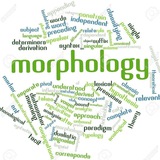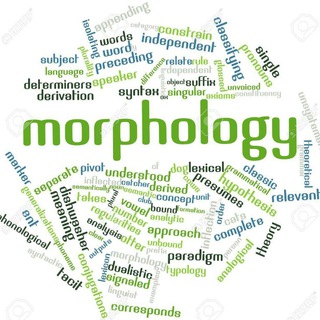Morphology
The branch of grammar which studies the structure of FORMS of WORDS,through the use of morpheme construct is called morphology.
@studylinguistics4
The branch of grammar which studies the structure of FORMS of WORDS,through the use of morpheme construct is called morphology.
@studylinguistics4
Morphology is generally divided into two fields:
1- Inflectional Morphology
2- Word Formation
@studylinguistics4
1- Inflectional Morphology
2- Word Formation
@studylinguistics4
Word
A word is the smallest unit of grammar which can stand alone as a complete utterance.It is a unit of expression in spoken and written language.
@studylinguistics4
A word is the smallest unit of grammar which can stand alone as a complete utterance.It is a unit of expression in spoken and written language.
@studylinguistics4
Note!
a. I’m mad at you.
b. Don’t take candy from strangers.
c. Why couldn’t you carry it more carefully?
d. You aren’t going out dressed like that, are you?
e. You’re not going out dressed like that, are you?
@studylinguitics4
a. I’m mad at you.
b. Don’t take candy from strangers.
c. Why couldn’t you carry it more carefully?
d. You aren’t going out dressed like that, are you?
e. You’re not going out dressed like that, are you?
@studylinguitics4
I’m aren’t they’ve the it don’t you’re we’re at are couldn’t he’s
It is difficult to apply this criterion consistently.
@studylinguistics4
It is difficult to apply this criterion consistently.
@studylinguistics4
orthographic word
An orthographic word is the unit bounded by spaces in the written language.
An orthographic word is the unit bounded by spaces in the written language.
phonological word
A phonological word is a unit in speech bounded by pauses. In English, every phonological word has a main stress. Elements that are written as separate words but do not have their own stress are therefore not phonological words in English.
Ex. hot dog
I don’t know.
@studylinguistics4
A phonological word is a unit in speech bounded by pauses. In English, every phonological word has a main stress. Elements that are written as separate words but do not have their own stress are therefore not phonological words in English.
Ex. hot dog
I don’t know.
@studylinguistics4
These are different realizations of the lexeme RECORD. They all share a core meaning. A lexeme is an abstract unit of morphological analysis that corresponds to a set of forms taken by a word.
@studylinguistics4
@studylinguistics4
Each of the forms taken by the word is called a word form. A physical realization of a lexeme is called a word form. Ex. Word Form see, seeing, saw, sees
catch, catches, catching boy, boys woman, women woman
The headwords of a dictionary are all lexemes.
@studylinguistics4
catch, catches, catching boy, boys woman, women woman
The headwords of a dictionary are all lexemes.
@studylinguistics4
grammatical word
A realization of a lexeme which has morphological and grammatical properties is called a grammatical word. Or: Different forms of a single word that occur depending on the syntactic context is a grammatical word.
@studylinguistics4
A realization of a lexeme which has morphological and grammatical properties is called a grammatical word. Or: Different forms of a single word that occur depending on the syntactic context is a grammatical word.
@studylinguistics4
EX.
1. I usually cut the bread with a knife. (verb/present) .
2. Yesterday I cut the bread on the table. (verb past).
3. have a cut on my finger (noun) .
@studylinguistics4
1. I usually cut the bread with a knife. (verb/present) .
2. Yesterday I cut the bread on the table. (verb past).
3. have a cut on my finger (noun) .
@studylinguistics4
Morphemes
Morphemes are the minimal units of words that have a meaning and cannot be subdivided further. There are two main types: free and bound. Free morphemes can occur alone and bound morphemes must occur with another morpheme. An example of a free morpheme is "bad", and an example of a bound morpheme is "ly." It is bound because although it has meaning, it cannot stand alone. It must be attached to another morpheme to produce a word.
Free morpheme: bad
Bound morpheme: ly
Word: badly
When we talk about words, there are two groups: lexical (or content) and function (or grammatical) words. Lexical words are called open class words and include nouns, verbs, adjectives and adverbs. New words can regularly be added to this group. Function words, or closed class words, are conjunctions, prepositions, articles and pronouns; and new words cannot be (or are very rarely) added to this class.
@studylinguistics4
Morphemes are the minimal units of words that have a meaning and cannot be subdivided further. There are two main types: free and bound. Free morphemes can occur alone and bound morphemes must occur with another morpheme. An example of a free morpheme is "bad", and an example of a bound morpheme is "ly." It is bound because although it has meaning, it cannot stand alone. It must be attached to another morpheme to produce a word.
Free morpheme: bad
Bound morpheme: ly
Word: badly
When we talk about words, there are two groups: lexical (or content) and function (or grammatical) words. Lexical words are called open class words and include nouns, verbs, adjectives and adverbs. New words can regularly be added to this group. Function words, or closed class words, are conjunctions, prepositions, articles and pronouns; and new words cannot be (or are very rarely) added to this class.
@studylinguistics4
Forwarded from THE STUDY OF LANGUAGE - Linguistics Across Achievement Tests
Etymology
Etymology (/ˌɛt.ɪˈmɒl.ə.dʒi/) is the study of the history of words, their origins, and how their form and meaning have changed over time. By extension, the term "the etymology (of a word)" means the origin of the particular word.
For a language like Greek with a long written history, etymologists make use of texts in these languages and texts about the languages to gather knowledge about how words were used during earlier periods of their history and when they entered the languages in question. Etymologists also apply the methods of comparative linguistics to reconstruct information about languages that are too old for any direct information to be available.
By analyzing related languages with a technique known as the comparative method, linguists can make inferences about their shared parent language and its vocabulary. In this way, word roots have been found that can be traced all the way back to the origin of, for instance, the Indo-European language family.
Even though etymological research originally grew from the philological tradition, currently much etymological research is done on language families where little or no early documentation is available, such as Uralic and Austronesian.
The word etymology is derived from the Greek word ἐτυμολογία (etumología), itself from ἔτυμον (étumon), meaning "true sense", and the suffix -logia, denoting "the study of".
In linguistics, the term etymon is used to refer to a word or morpheme (e.g. stem or root ) from which a later word is derived. For example, the Latin word candidus, which means "white", is the etymon of English candid.
@studylinguistics4
Etymology (/ˌɛt.ɪˈmɒl.ə.dʒi/) is the study of the history of words, their origins, and how their form and meaning have changed over time. By extension, the term "the etymology (of a word)" means the origin of the particular word.
For a language like Greek with a long written history, etymologists make use of texts in these languages and texts about the languages to gather knowledge about how words were used during earlier periods of their history and when they entered the languages in question. Etymologists also apply the methods of comparative linguistics to reconstruct information about languages that are too old for any direct information to be available.
By analyzing related languages with a technique known as the comparative method, linguists can make inferences about their shared parent language and its vocabulary. In this way, word roots have been found that can be traced all the way back to the origin of, for instance, the Indo-European language family.
Even though etymological research originally grew from the philological tradition, currently much etymological research is done on language families where little or no early documentation is available, such as Uralic and Austronesian.
The word etymology is derived from the Greek word ἐτυμολογία (etumología), itself from ἔτυμον (étumon), meaning "true sense", and the suffix -logia, denoting "the study of".
In linguistics, the term etymon is used to refer to a word or morpheme (e.g. stem or root ) from which a later word is derived. For example, the Latin word candidus, which means "white", is the etymon of English candid.
@studylinguistics4
This channel consist of linguistics tests.Preparing candidates for M.A/Ph.D. Entrance exam competitions and promoting the quality of B.A teaching&learning.
Link: https//telegram.me/studylinguistics3
Admin: @Dilbilimsel1linguistics1
Info: @Samanzarei
Link: https//telegram.me/studylinguistics3
Admin: @Dilbilimsel1linguistics1
Info: @Samanzarei
Telegram
THE STUDY OF LANGUAGE - Linguistics Across Achievement Tests
This channel consist of linguistics tests.Preparing candidates for M.A/Ph.D. Entrance exam competitions and promoting the quality of B.A teaching&learning.
Link: https//telegram.me/studylinguistics3
Admin:
Info: @dlinguistics2
Link: https//telegram.me/studylinguistics3
Admin:
Info: @dlinguistics2

